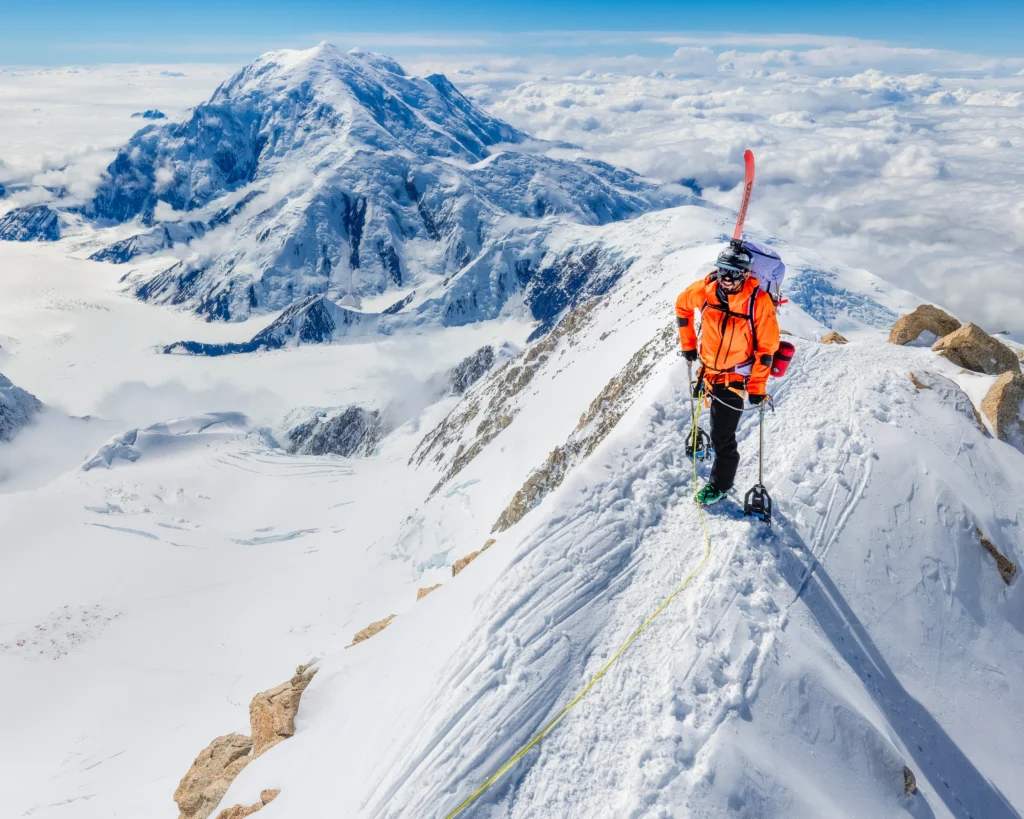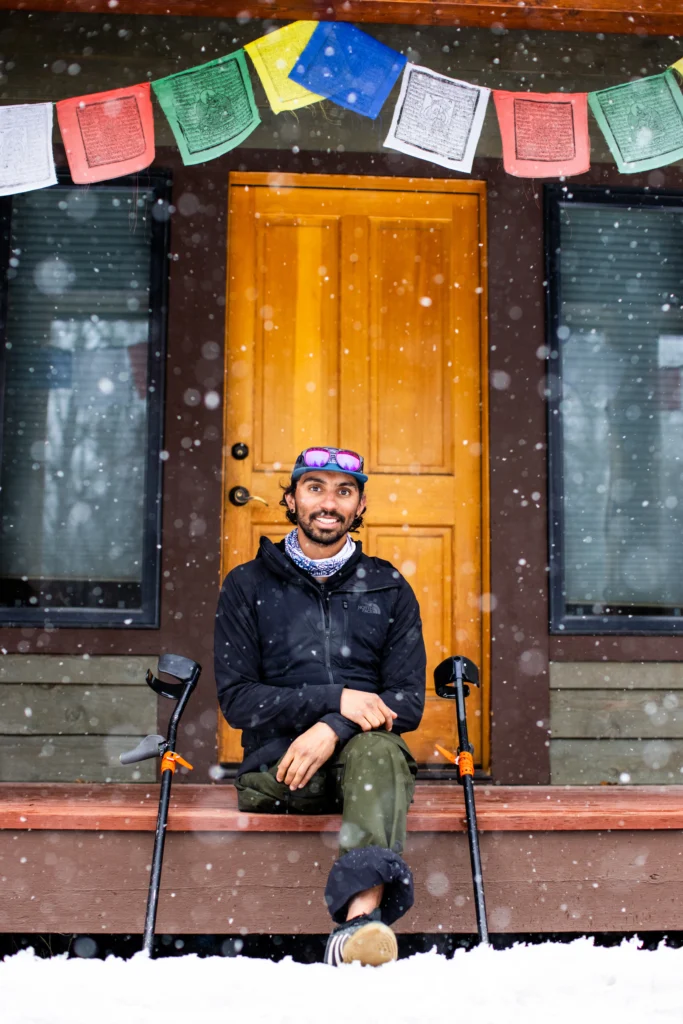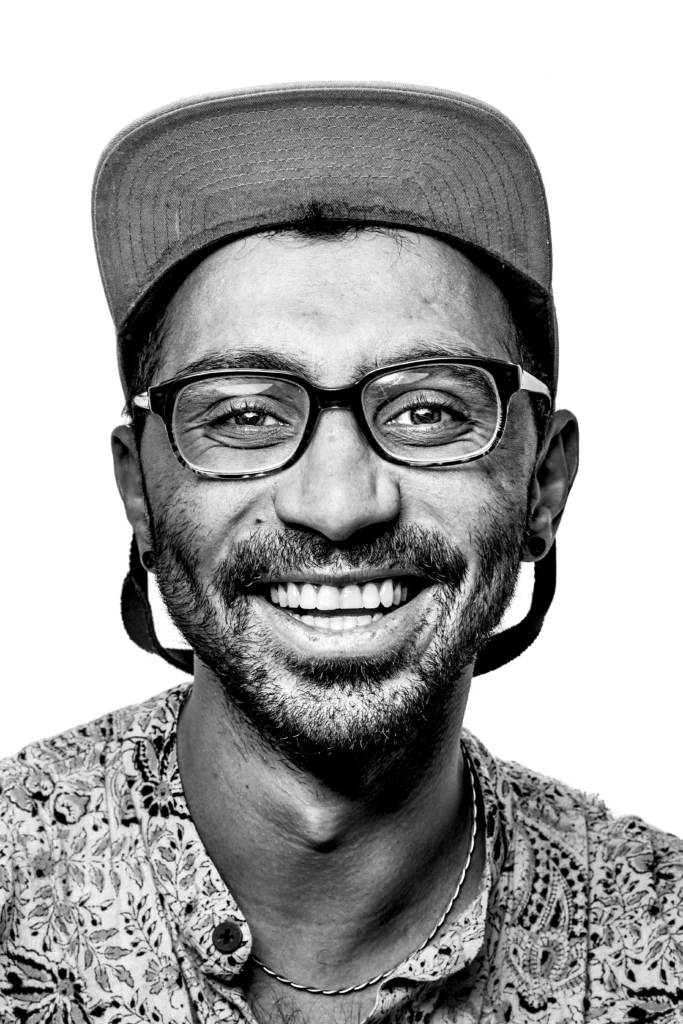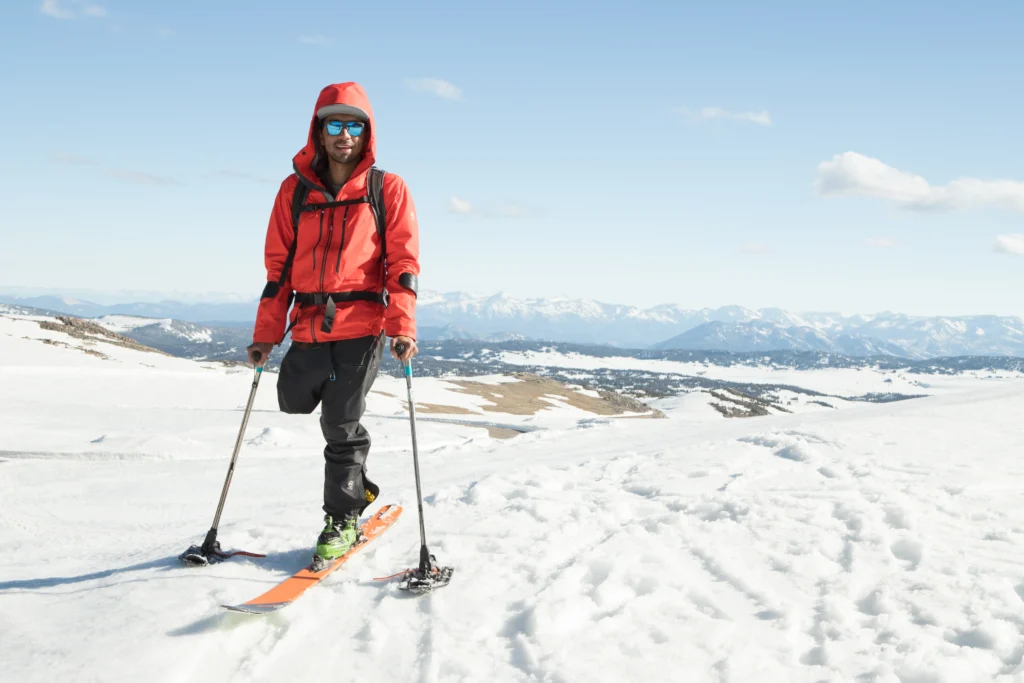
Listen to this Article
Vasu Sojitra is a professional skier, U.S. national amputee soccer player, and disability access strategist. After losing his right leg to a blood infection before his first birthday, he grew up redefining what it means to move through the world, turning travel, sport, and advocacy into inseparable parts of his life.
Vasu Sojitra’s calendar is a carousel of flights, slopes, soccer fields and wild landscapes that keep him in near-constant motion. Twice a month on average, he’s in the air or on the road. The destinations change, the purpose shifts, but one thing stays the same: every trip adds another layer to how he sees the world and how he helps shape it.
Winter tilts toward skiing. Sometimes it’s a film shoot in Alaska, a sponsor event in Europe or a personal project in the backcountry of Montana. When the snow melts, travel pivots to amputee soccer, trail running or camping trips that double as recovery and training. And in between, he squeezes in consulting gigs, speaking engagements and the kind of outdoor adventures most people only dream of.
The rhythm could flatten even the most hardened frequent flyer. Delays, layovers, airports where everything has to line up. Yet he treats it as part of the adventure. “At the end of the day, it all works out,” he says with a shrug, as if multiple flights and gear hauls were as routine as checking his phone.
Vasu Sojitra lost his right leg but instead of sidelining him, it simply became part of how he moves through the world. Today he’s one of the few professional skiers with a disability, a U.S. national amputee soccer player, and an advocate pushing outdoor spaces and industries to be more inclusive.
In all of his travels, one trip stands out for him: Gulmarg, India. Here in the high-altitude terrain where gondolas rise above 11,000 feet, breathing feels like work but for Sojitra, the experience was fulfilling and emotional, going beyond the mere act of skiing. He was in his ancestral homeland! He calls himself Indian American, but resists being boxed into one label. That duality of immigrant roots and American upbringing coupled with being an adaptive athlete and community builder follows him on every trip. It’s why skiing in Gulmarg carried more meaning than just being another powder day. It was a return to ancestral ground and a reminder that identity can travel with you, wherever you carve your path. Disability in public life is rarely visible in this region and, “Many of the people had never seen an adaptive skier before,” he says. In that run, he reshaped perceptions of disability and showcased what is possible to people in his ancestral homeland.
Travel, for him, is rarely just logistics. It’s showing up in a new place and creating connection. Sometimes that means carving lines through Alaskan powder. Other times it’s sitting across from teammates at soccer qualifiers in Mexico. Always, it’s a way of tying together identity, sport, disability, accessibility and exploration, while pushing for outdoor spaces and communities to be more open, inclusive and ready for everyone.


Travel isn’t limited to his personal career either. In 2020, he co-founded the Inclusive Outdoors Project, which focuses on breaking barriers in outdoor recreation for disabled athletes and marginalized communities. The initiative runs ice climbing clinics, trail running events and avalanche safety courses tailored to adaptive athletes . . . one of the only programs of its kind. Participants come from across the U.S. and even Canada, travelling to Montana to access training and community that rarely exist elsewhere. A local Bozeman chapter expands the effort with bike maintenance nights, mountain biking, yoga and foraging workshops, opening the outdoors to people who might otherwise feel shut out. What began as a small idea has grown into a model for how accessibility and community can transform outdoor culture. Some arrive never having touched a pair of skis or climbing tools before but they leave with skills, community and the confidence to return.
Sojitra sees these programs as travel in another form: people crossing borders, state lines or comfort zones to discover something bigger than themselves. And it works both ways. When participants travel to Montana, they bring stories, perspectives and cultural backgrounds that enrich the experience for everyone. The programs become crossroads, where movement equals transformation.
His travels also influence the outdoor industry. Partnering with The North Face, he’s been helping develop universally designed tents, sleeping bags and backpacks set to launch next spring. The goal isn’t to create niche “adaptive-only” gear, but to design equipment that’s intuitive and functional for everyone, whether that’s a tent that can be pitched more easily with limited mobility, or a sleeping bag with no zipper that can be used in freezing temperatures without a struggle. These are improvements that make life easier for the broadest range of people. It’s travel gear in the purest sense: tools that help anyone move more freely through the world. By weaving inclusive design into mainstream product lines, Sojitra pushes the industry to rethink who belongs in the outdoors, and to recognize that accessibility benefits everyone, not just a specific community. His advocacy makes clear that the future of outdoor gear isn’t specialized, it’s universal.
Talk to him long enough and a travel wish list spills out: skiing Japan’s deep powder, running trails through the Dolomites, tackling Aconcagua in South America, maybe even skiing an 8,000-metre peak in Nepal. Each trip, whether planned or still on the horizon, reflects his hunger to keep pushing into new territory.
Alaska remains a favourite. Every year, he heads north to Haines for heli-skiing, a combination of pure thrill and breathtaking scenery. And British Columbia has impressed him with its diversity of people in winter sports, something he notices sharply, given how white-dominated ski culture often feels.
For Sojitra, travel is the glue between athleticism, community and identity. It’s what lets him balance the grind of training with the joy of exploration. It’s how he keeps close to family and friends, while also building new networks across borders.
Balance, he admits, is tricky. It means eating well on the road, finding time to rest, keeping up workouts between flights, and staying grounded with calls home. But the constant movement doesn’t drain him, it sustains him. “A lot of my travel is based around athleticism, so that helps,” he says. The training and the travel are intertwined.


At the heart of it, travel is his way of staying connected to the outdoors. Fresh air, fresh water, wild landscapes, they’re not luxuries, he says, but birthrights. And birthrights should be accessible. For Sojitra, that means more than chasing his own adventures. It means making sure others can reach them too. Every trip becomes a form of advocacy, whether he’s testing new universally designed gear on a ski expedition, or hosting avalanche courses that welcome adaptive athletes into backcountry spaces once considered off-limits. The more people experience the outdoors, the stronger the bond between humans and the planet, and the stronger the call to protect both. That’s why he pushes himself to travel widely, build bridges for others, and challenge industries to keep up. Each boarding pass, trail and peak is a reminder that travel, for an adaptive athlete like Sojitra, is both personal freedom and public advocacy, incrementally reshaping how the world sees disability, and proving that accessibility belongs everywhere!
Follow Vasu Sojitra
Vasu’s approach to travel comes with lessons worth carrying on any journey
- See travel as part of the adventure:even delays and gear hauls have their place
- Train on the move:build trips around athleticism to stay strong and balanced
- Push for universal design:gear should work for everyone, not just a niche group
- Create access for others:bring new communities into outdoor spaces through clinics and events
- Value layered identity:culture, disability, and sport can travel together
- Remember, visibility matters:representation reshapes what others believe is possible
- Stay grounded on the road:eat well, rest, and keep up workouts between flights
- Keep connections alive:regular calls with family and friends help balance constant motion
